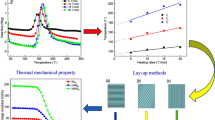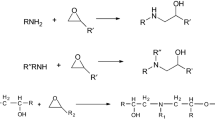Abstract
As packaging technologies are demanded that reduce the assembly area of substrate, thin composite laminate substrates require the utmost high performance in such material properties as the coefficient of thermal expansion (CTE), and stiffness. Accordingly, thermosetting resin systems, which consist of multiple fillers, monomers and/or catalysts in thermoset-based glass fiber prepregs, are extremely complicated and closely associated with rheological properties, which depend on the temperature cycles for cure. For the process control of these complex systems, it is usually required to obtain a reliable kinetic model that could be used for the complex thermal cycles, which usually includes both the isothermal and dynamic-heating segments. In this study, an ultra-thin prepreg with highly loaded silica beads and glass fibers in the epoxy/amine resin system was investigated as a model system by isothermal/dynamic heating experiments. The maximum degree of cure was obtained as a function of temperature. The curing kinetics of the model prepreg system exhibited a multi-step reaction and a limited conversion as a function of isothermal curing temperatures, which are often observed in epoxy cure system because of the rate-determining diffusion of polymer chain growth. The modified kinetic equation accurately described the isothermal behavior and the beginning of the dynamic-heating behavior by integrating the obtained maximum degree of cure into the kinetic model development.
Similar content being viewed by others
References
Fava, R.A., 1968, Differential scanning calorimetry of epoxy resins, Polymer 9, 137–151.
Garschke, C., P.P. Parlevliet, C. Weimer, and B.L. Fox, 2013, Cure kinetics and viscosity modelling of a high-performance epoxy resin film, Polym. Test 32, 150–157.
Halley, P.J. and M.E. Mackay, 1996, Chemorheology of thermosets -an overview, Polym. Eng. Sci. 36, 593–609.
Kim, J., T.J. Moon, and J.R. Howell, 2002, Cure Kinetic model, heat of reaction, and glass transition temperature of AS4/3501-6 graphite-epoxy prepregs, J. Compos. Mater. 36, 2479–2498.
Kim, Y.C., H. Min, J. Yu, J. Suhr, Y.K. Lee, K.J. Kim, S.H. Kim, and J.-D. Nam, 2016, Nonlinear and complex cure kinetics of ultra-thin glass fiber epoxy prepreg with highly-loaded silica bead under isothermal and dynamic-heating conditions, Thermochim. Acta 644, 28–32.
Kubota, H., 1975, Curing of highly reactive polyester resin under pressure: Kinetic studies by differential scanning calorimetry, J. Appl. Polym. Sci. 19, 2279–2297.
Matsuoka, S., X. Quan, H.E. Bair, and D.J. Boyle, 1989, A model for the curing reaction of epoxy resins, Macromolecules 22, 4093–4098.
Nam, J.-D. and J.C. Seferis, 1991, A composite methodology for multistage degradation of polymers, J. Polym. Sci. Pt. BPolym. Phys. 29, 601–608.
Nam, J.-D. and J.C. Seferis, 1992, Generalized composite degradation kinetics for polymeric systems under isothermal and nonisothermal conditions, J. Polym. Sci. Pt. B-Polym. Phys. 30, 455–463.
Ng, H. and I. Manas-zloczower, 1989, A nonisothermal differential scanning calorimetry study of the curing kinetics of an unsaturated polyester system, Polym.Eng. Sci. 29, 1097–1102.
Park, I.-K., D.-S. Lee, and J.-D. Nam, 2002, Equivalent processing time analysis of glass transition development in epoxy/carbon fiber composite systems, J. Appl. Polym. Sci. 84, 144–154.
Prime, R.B., 1973, Differential scanning calorimetry of the epoxy cure reaction, Polym.Eng. Sci. 13, 365–371.
Prime, R.B. and E.A. Turi, 1981, Thermal characterization of polymeric materials, Turi, EA, Ed 1380.
Shim, H.-Y., J.-J. Shim, J.-A. Kang, and H.-S. Min, 2012, Thermosetting resin composition and prepreg and metal clad laminate using the same, US Patent US9278505 B2.
Turi, E.A., 1981, Thermal Characterization of Polymeric Materials, Academic Press, Inc., New York.
Vyazovkin, S., A.K. Burnham, J.M. Criado, L.A. Pérez-Maqueda, C. Popescu, and N. Sbirrazzuoli, 2011, ICTAC Kinetics committee recommendations for performing kinetic computations on thermal analysis data, Thermochim. Acta 520, 1–19.
Yousefi, A., P.G. Lafleur, and R. Gauvin, 1997, Kinetic studies of thermoset cure reactions: A review, Polym. Compos. 18, 157–168.
Author information
Authors and Affiliations
Corresponding author
Rights and permissions
About this article
Cite this article
Kim, Y.C., Min, H., Hong, S. et al. Multi-step cure kinetic model of ultra-thin glass fiber epoxy prepreg exhibiting both autocatalytic and diffusion-controlled regimes under isothermal and dynamic-heating conditions. Korea-Aust. Rheol. J. 29, 157–162 (2017). https://doi.org/10.1007/s13367-017-0017-z
Received:
Revised:
Accepted:
Published:
Issue Date:
DOI: https://doi.org/10.1007/s13367-017-0017-z




